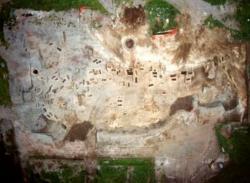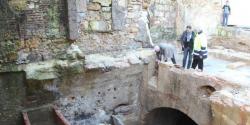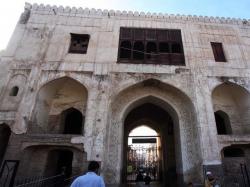INSTITUT SUPERIEUR D'ANTHROPOLOGIE
INSTITUTE OF ANTHROPOLOGY
ONLINE COURSES / COURS A DISTANCE
SPRING TERM : APRIL 2014
REGISTER NOW
ITALIE –  Concordia Sagittaria - The largest, best-preserved ancient Roman funerary complex found in Italy since the 19th century has been discovered at an archeological dig 70 km northeast of Venice, researchers announced Friday. An imposing monument from the third century AD was located outside the ancient walls of what was once the Roman colony of Iulia Concordia, now in the town of Concordia Sagittaria. The site was likened to a "little, flood-plain Pompeii" in a guided tour at the restoration site in Gruaro, Veneto. Just as Pompeii was buried by the volcanic eruption of Mount Vesuvius in 79 AD, a natural disaster wiped out and preserved sarcophagi in Iulia Concordia. Floods swept detritus and sediment across the area in the fifth century AD, rendering the ancient structures inaccessible and invisible for 1500 years. The complex includes a podium nearly two metres tall and six metres long with the remains of two elegant sarcophagi on top, two others nearby, and the base of a third. The remains of a necropolis from the the late first century B.C. was also found. The excavation is financed by the Region of Veneto with European Union funds under the direction of the Veneto Superintendency for Archeological Heritage. (ANSAmed).
Concordia Sagittaria - The largest, best-preserved ancient Roman funerary complex found in Italy since the 19th century has been discovered at an archeological dig 70 km northeast of Venice, researchers announced Friday. An imposing monument from the third century AD was located outside the ancient walls of what was once the Roman colony of Iulia Concordia, now in the town of Concordia Sagittaria. The site was likened to a "little, flood-plain Pompeii" in a guided tour at the restoration site in Gruaro, Veneto. Just as Pompeii was buried by the volcanic eruption of Mount Vesuvius in 79 AD, a natural disaster wiped out and preserved sarcophagi in Iulia Concordia. Floods swept detritus and sediment across the area in the fifth century AD, rendering the ancient structures inaccessible and invisible for 1500 years. The complex includes a podium nearly two metres tall and six metres long with the remains of two elegant sarcophagi on top, two others nearby, and the base of a third. The remains of a necropolis from the the late first century B.C. was also found. The excavation is financed by the Region of Veneto with European Union funds under the direction of the Veneto Superintendency for Archeological Heritage. (ANSAmed).
http://www.ansamed.info/ansamed/en/
CHINE - 
 Kezer - Urgent conservation work is needed to save a series of caves in northwest China containing ancient murals by Buddhist monks, which are threatened with destruction from the forces of nature. The network of 236 sandstone caves extend over an area of two to three kilometres in the vast, sparsely-populated autonomous Xinjiang region of China, along the ancient Silk Road. The caves were inhabited by Buddhist monks and used as temples between the third and the eighth centuries, and are lined with murals providing a rich picture of early Buddhist culture. The caves, known locally as Kezer, are prone to deterioration, particularly from moisture, because of their geological composition, which includes many soluble salts. Although the region is very dry, any rainwater could have “distastrous consequences”, according to Giorgio Bonsanti, an expert in wall painting preservation. He told our sister paper, Il Giornale dell’Arte, “the signs of progressive decay, which in the long term would turn everything to sand, are dramatically evident.” Bonsanti said that there have been efforts to buttress the mountains with cement and horizontal metal poles, which anchor the external layers of stone to more solid rock, but these fortifications are proving insufficient in the bid to save the caves. The murals are particularly significant because of their stylistic similarity to Indian, rather than classical Chinese, art, which bears witness to the transmission of Buddhism to China from the south. In the early 20th century, many of the paintings were removed by Western archaeologists
Kezer - Urgent conservation work is needed to save a series of caves in northwest China containing ancient murals by Buddhist monks, which are threatened with destruction from the forces of nature. The network of 236 sandstone caves extend over an area of two to three kilometres in the vast, sparsely-populated autonomous Xinjiang region of China, along the ancient Silk Road. The caves were inhabited by Buddhist monks and used as temples between the third and the eighth centuries, and are lined with murals providing a rich picture of early Buddhist culture. The caves, known locally as Kezer, are prone to deterioration, particularly from moisture, because of their geological composition, which includes many soluble salts. Although the region is very dry, any rainwater could have “distastrous consequences”, according to Giorgio Bonsanti, an expert in wall painting preservation. He told our sister paper, Il Giornale dell’Arte, “the signs of progressive decay, which in the long term would turn everything to sand, are dramatically evident.” Bonsanti said that there have been efforts to buttress the mountains with cement and horizontal metal poles, which anchor the external layers of stone to more solid rock, but these fortifications are proving insufficient in the bid to save the caves. The murals are particularly significant because of their stylistic similarity to Indian, rather than classical Chinese, art, which bears witness to the transmission of Buddhism to China from the south. In the early 20th century, many of the paintings were removed by Western archaeologists
http://www.theartnewspaper.com/articles/Ancient-Buddhist-caves-in-China-could-turn-to-sand/31831
FRANCE –  Bergerac - Les vestiges médiévaux mis au jour en 2013 à Bergerac seront valorisés. Ils apportent un témoignage essentiel sur le passé industriel de la ville. sous les pavés, point de plage, mais un pan entier de l'histoire bergeracoise. « Un des complexes médiévaux les plus importants de Bergerac. Une découverte archéologique majeure », sourit Fabien Ruet. « Il y a des sites qui concentrent plus que d'autres les traces d'une civilisation », confirme Yan Laborie. Alors les vestiges du Moulin de Piles ne seront très certainement pas reproduits pour être montrés dans le monde entier à l'instar des fresques de Lascaux, leur importance au niveau local est de taille. Car cette découverte va donner des éléments « très instructifs », selon le conservateur bergeracois, sur le canal du Caudeau. « Tout le monde le connaît, explique Yan Laborie. Mais il est mystérieux. Il traverse la ville, parfois on l'entend chanter. » Pour lui, il y a donc un important point d'intérêt « à le rouvrir ici ». Avant que le site, visible désormais de tous, entre l'ancienne minoterie et le musée de la Batellerie, soit dégagé, il a fallu faire quelques travaux. Notamment ôter le bitume et la dalle de béton qui cachaient ce « trésor ». « L'ouverture que nous avons pratiquée a montré une structure qui va nous permettre d'expliquer la raison de cet aménagement, de cette infrastructure hydraulique. » Laquelle, selon Yan Laborie, aurait été construite entre 1250 et 1400 et prouve que ce fameux canal était « l'artère vitale » qui apportait l'eau. Elle a donc approvisionné le moulin dont l'arrêt de l'activité date certainement de l'Entre-Deux-Guerres. Ainsi, Bergerac serait « fille du Caudeau », estime Fabien Ruet.
Bergerac - Les vestiges médiévaux mis au jour en 2013 à Bergerac seront valorisés. Ils apportent un témoignage essentiel sur le passé industriel de la ville. sous les pavés, point de plage, mais un pan entier de l'histoire bergeracoise. « Un des complexes médiévaux les plus importants de Bergerac. Une découverte archéologique majeure », sourit Fabien Ruet. « Il y a des sites qui concentrent plus que d'autres les traces d'une civilisation », confirme Yan Laborie. Alors les vestiges du Moulin de Piles ne seront très certainement pas reproduits pour être montrés dans le monde entier à l'instar des fresques de Lascaux, leur importance au niveau local est de taille. Car cette découverte va donner des éléments « très instructifs », selon le conservateur bergeracois, sur le canal du Caudeau. « Tout le monde le connaît, explique Yan Laborie. Mais il est mystérieux. Il traverse la ville, parfois on l'entend chanter. » Pour lui, il y a donc un important point d'intérêt « à le rouvrir ici ». Avant que le site, visible désormais de tous, entre l'ancienne minoterie et le musée de la Batellerie, soit dégagé, il a fallu faire quelques travaux. Notamment ôter le bitume et la dalle de béton qui cachaient ce « trésor ». « L'ouverture que nous avons pratiquée a montré une structure qui va nous permettre d'expliquer la raison de cet aménagement, de cette infrastructure hydraulique. » Laquelle, selon Yan Laborie, aurait été construite entre 1250 et 1400 et prouve que ce fameux canal était « l'artère vitale » qui apportait l'eau. Elle a donc approvisionné le moulin dont l'arrêt de l'activité date certainement de l'Entre-Deux-Guerres. Ainsi, Bergerac serait « fille du Caudeau », estime Fabien Ruet.
http://www.sudouest.fr/2014/02/24/une-decouverte-qui-eclaire-l-histoire-de-la-ville-1471247-1733.php
PAKISTAN –  Peshawar - The Khyber-Pakhtunkhwa (K-P) Archaeology Department has complained to the Municipal Corporation Peshawar (MCP) about dumpers and other vehicles parked at the historic Gor Gathri compound.The department has asked MCP to shift its vehicles, saying it disturbs tourist activities.An official of the archaeology department had said then that the trucks posed a threat to both gates of the complex, which date back to the Mughal period.
Peshawar - The Khyber-Pakhtunkhwa (K-P) Archaeology Department has complained to the Municipal Corporation Peshawar (MCP) about dumpers and other vehicles parked at the historic Gor Gathri compound.The department has asked MCP to shift its vehicles, saying it disturbs tourist activities.An official of the archaeology department had said then that the trucks posed a threat to both gates of the complex, which date back to the Mughal period.
http://tribune.com.pk/story/675289/misplaced-priorities-gor-gathri-turns-into-a-parking-lot-again/
FRANCE –  Echiré -Classé monument historique, Coudray-Salbart est considéré comme l'un des plus importants châteaux du début du XIIIe en Europe pour la qualité de son architecture défensive. La première occupation du site reste toutefois méconnue ainsi que les raisons de son abandon. « Les interventions réalisées au cours des dernières années ont permis de montrer qu'une occupation perdure au moins jusqu'au XVIe siècle. » Propriété de la CAN, il a fait l'objet de nombreux chantiers de restauration sous la maîtrise de l'architecte en chef des Monuments historiques : la première phase a concerné la tour du Portal (2005), la courtine ouest (2006), la grosse tour (2008-2009). La deuxième tranche a débuté par la tour Bois-Berthier et se poursuit par la tour du Moulin. La fouille préventive menée actuellement par l'Inrap (Institut national des recherches archéologiques préventives) a débuté le 10 février.
Echiré -Classé monument historique, Coudray-Salbart est considéré comme l'un des plus importants châteaux du début du XIIIe en Europe pour la qualité de son architecture défensive. La première occupation du site reste toutefois méconnue ainsi que les raisons de son abandon. « Les interventions réalisées au cours des dernières années ont permis de montrer qu'une occupation perdure au moins jusqu'au XVIe siècle. » Propriété de la CAN, il a fait l'objet de nombreux chantiers de restauration sous la maîtrise de l'architecte en chef des Monuments historiques : la première phase a concerné la tour du Portal (2005), la courtine ouest (2006), la grosse tour (2008-2009). La deuxième tranche a débuté par la tour Bois-Berthier et se poursuit par la tour du Moulin. La fouille préventive menée actuellement par l'Inrap (Institut national des recherches archéologiques préventives) a débuté le 10 février.
http://www.lanouvellerepublique.fr/Deux-Sevres/Actualite/24-Heures/n/Contenus/Articles/2014/02/23/Deuxieme-tranche-de-restauration-1806950
ROYAUME UNI –  Broxmouth - Researchers at the University of Bradford say that they have identified the earliest use of steel in the UK. It is now believed that artifacts recovered (in the 1970s) from Broxmouth Iron Age hill fort in East Lothian were manufactured in the years 490-375BC from high-carbon steel. The re-appraisal of the steel objects follows six years of investigation by experts at the university — financed by the Society of Antiquaries of Scotland, Historic Scotland and the Arts and Humanities Research Council. Gerry McDonnell — an expert in archaeological metals who was part of the investigating team — says that the high-carbon steel remains, which had been heated and quenched in water, “indicate the beginnings of steel manufacturing in Scotland”. He added: “The process of manufacturing steel requires extensive knowledge, skill and craftsmanship. Such an early example of its production tells us so much about the people who once occupied this hill fort. It points to an advanced, organised community where complex skills were refined and passed on. “Technical skills at this level would only be achievable by specialist metal-workers, who devoted their lives to perfecting and developing their craft — some might say the first example of a Scottish ‘knowledge economy’. Such specialisation could only have happened with the practical support of the wider community at Broxmouth and beyond; it is a poignant start to the story of iron and steel manufacture in Scotland.” The Broxmouth site was in use until the time of Roman occupation. After near-total excavation, the site is now occupied by a cement works.
Broxmouth - Researchers at the University of Bradford say that they have identified the earliest use of steel in the UK. It is now believed that artifacts recovered (in the 1970s) from Broxmouth Iron Age hill fort in East Lothian were manufactured in the years 490-375BC from high-carbon steel. The re-appraisal of the steel objects follows six years of investigation by experts at the university — financed by the Society of Antiquaries of Scotland, Historic Scotland and the Arts and Humanities Research Council. Gerry McDonnell — an expert in archaeological metals who was part of the investigating team — says that the high-carbon steel remains, which had been heated and quenched in water, “indicate the beginnings of steel manufacturing in Scotland”. He added: “The process of manufacturing steel requires extensive knowledge, skill and craftsmanship. Such an early example of its production tells us so much about the people who once occupied this hill fort. It points to an advanced, organised community where complex skills were refined and passed on. “Technical skills at this level would only be achievable by specialist metal-workers, who devoted their lives to perfecting and developing their craft — some might say the first example of a Scottish ‘knowledge economy’. Such specialisation could only have happened with the practical support of the wider community at Broxmouth and beyond; it is a poignant start to the story of iron and steel manufacture in Scotland.” The Broxmouth site was in use until the time of Roman occupation. After near-total excavation, the site is now occupied by a cement works.
http://www.machinery-market.co.uk/news/5549/Earliest-use-of-steel-in-the-UK-identified?